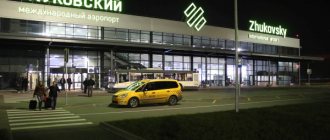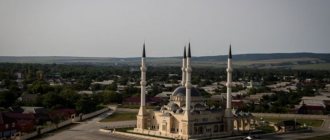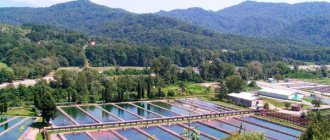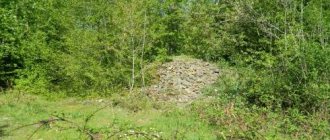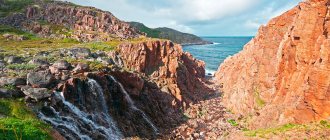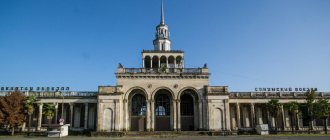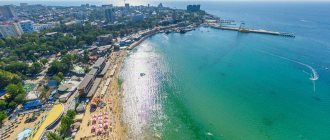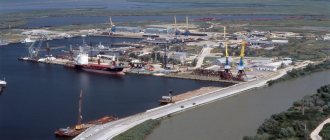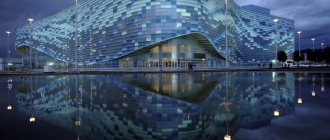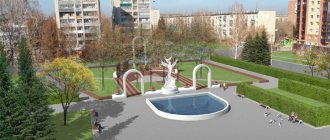Azov is deservedly one of the most interesting cities in the Rostov region. Agree, there are not many cities in the world that gave their name to the sea; not many cities can boast that every schoolchild knows the pages of its history, remember at least the “Azov siege” or the Azov campaigns of Peter I; Not many cities influenced the course of development of the history of an entire country.
However, despite the heroic past, the sights of Azov, which have preserved the spirit of this past to this day, are very few in number. All of them are located in close proximity to each other, so you can see everything in 1 day.
In this post I will tell you how best to organize a walking route around Azov so as not to miss anything interesting.
How to download the map and use it offline, read here
The importance of the city in the modern world
Modern Azov is a small city with an area of 67.5 km2. At the same time, it is a developed industrial center. Here are the Azov Shipyard, engineering, chemical, construction, light industry and trade enterprises, including a baby food enterprise, the largest in Europe.
Azov organizations produce:
- metalworking equipment;
- special equipment;
- Construction Materials;
- transformer substations;
- optical products;
- metal structures;
- medical devices;
- paint and varnish products;
- agricultural machinery;
- equipment for polymer processing.
The city's large international port is designed to deliver goods from north to south and work with cargo flows in the Mediterranean and Southern European directions. This is the main transport hub connecting the waterways of Russia with the Mediterranean Sea. The enterprise processes about 2 million tons of cargo annually at 11 berths.
Distinctive features of the city
The features of Azov are determined by its geographical location and natural and climatic conditions.
Climate
Azov has a temperate continental climate, weakened by the influence of the Azov Sea. Summers here are usually hot, and winters are quite mild, with little rainfall. The average annual temperature is +10°C.
The average January temperature is -4°C. The average July temperature is +23°C. On some days the temperature can rise above 30 degrees. The flat position of the city contributes to the formation of winds in winter. In summer the wind weakens.
Ecology
The main environmental problems of Azov are air dust and pollution of the Don River with metals and chemical compounds. Microbiological indicators of water at water intake sites indicate an increased degree of epidemiological danger.
Azov, whose attractions include not only historical monuments, but also recreational parks for citizens and guests of the city, shows the concern of residents and leadership for the environmental situation of the region. The city holds environmental cleanup days and events aimed at improving environmental safety and environmental culture of residents.
Population
The city is home to just over 82 thousand people. The most numerous residents are Russians - about 94%. Ukrainians, Belarusians and representatives of other nationalities also live in the city. The share of the city's male population has been 45% for many years.
Many famous people lived in Azov. The city Administration website lists the names of 24 honorary citizens of Azov. Arctic explorer Rudolf Lazarevich Samoilovich was born in the city.
How to get there
The most convenient way to come to Azov from any region of Russia is through the regional center, whose airport receives planes from many cities in Russia and other countries. You can also travel to the regional center by rail from Moscow, St. Petersburg and other cities. There are trains, commuter buses and minibuses running from Rostov-on-Don to Azov.
The distance between the cities is 27 km, so a bus trip lasts about 40 minutes, an electric train gets to Azov in about 1 hour. The average cost of a bus ticket is 83 rubles, a train ticket costs 70 rubles.
Recreation and entertainment
Azov, whose attractions attract Russian and foreign travelers, provides city guests with many opportunities for recreation and entertainment. The city has billiard clubs, karaoke clubs, entertainment centers, bars, cafes and restaurants. You can dance and watch shows in the Tortuga tavern, located on the banks of the Don.
The Krepostnoy Val restaurant is famous for its cozy atmosphere, relaxed atmosphere and good service.
The theatrical life of the city is represented by the folk children's theater "Gorodok" and the theater "KUL-SHOW", offering viewers interesting performances, shows, television projects and films.
Of interest to anglers is fishing on the Don, which is popular among connoisseurs and is rich in fish that live there. Lucky fishermen can catch pike perch weighing up to 7 kg. Catfish is considered a good catch. On the territory of the city there are green areas: a park of culture and recreation and the Pearl of Azov Park. The river station invites tourists on river walks and excursions on motor ships.
Every year in the first days of August, a festival of military history clubs takes place in Azov, which lasts several days. The main event of the festival is a theatrical reconstruction of the Cossacks sitting during the siege on the historical site of their feat - the ramparts.
Don't miss the most popular article in the section: Metro Nizhny Novgorod. Diagram, map, description.
Comments
nataliyak
13.06.17 17:19
What a cute town! And the river is so beautiful and fortress. Fortresses are generally my weakness. To this day, seeing them gives me the same feeling as seeing an adventure book in childhood. How lucky, Anna, that you decided to stay there. Even reading, I feel pleasure from this walk. For you, of course, these emotions were much stronger.
- answer
annas
13.06.17 20:18
Yes, Azov turned out to be not a “transit” place for us. Surprisingly quiet, but interesting and diverse town
- answer
galina
13.06.17 17:50
I really liked Azov. What views! Nature. The architecture is very nice. Monuments. I wanted to go myself. Anya, as I understand it, you watched all this in half a day?
- answer
annas
13.06.17 20:16
Galya, to be honest, half a day should have been added. So that you can explore the museum without haste, and the city, and look into a small museum.
- answer
olgap
13.06.17 23:41
Galya, one day is enough for everything. Add the Pogrebok Museum.
- answer
galina
13.06.17 23:45
Thank you, Ol! We'll be in Rostov. Two overnights and one full day. I think it’s better to see Rostov or go to Azov. Or maybe to Taganrog...)))
- answer
olgap
13.06.17 23:53
What to see in Rostov?! Not really anything. I would recommend either Azov, or Starocherkassk, or Taganrog. But as a traveler, I would choose Starochek. Here's something with a twist, with the spirit of the Don. You need to spend the night in Taganrog. And Azov and Starochek are just a stone's throw from Rostov.
- answer
galina
13.06.17 23:58
Thanks for the advice... I'll think about it. And about Rostov... I didn’t really see anything there. I’ve been there many times, but always passing through, only overnight stays. Or we met with friends, had a meal, talked. And the city remains on the sidelines year after year...
- answer
elenas
14.06.17 00:04
The controversial issue is that there is nothing to see in Rostov)))) We were in Rostov for a week. Seryozha worked, and I walked. Yes, I dedicated one day from morning to evening to Azov, I really liked it, but the rest of the days I walked around Rostov without any imagination. Every day there was something new. There is a lot to see in the city, but I am firmly convinced that any city is interesting, even the smallest one…. and Rostov is not small)))
- answer
galina
14.06.17 00:38
#10
I really want to understand what he is like. We haven't understood yet. Lenok, well, you were lucky - you had so many days in Rostov... I can imagine how you mastered it and experienced it... Great...
- answer
olgap
13.06.17 23:47
#11
Cobblestone pavements are not uncommon in southern cities. We have it in Taganrog. There is a whole square in Novocherkassk.
- answer
olgap
13.06.17 23:58
#12
Galya, if you choose Azov and this summer, you can add the Pavlo-Ochakovskaya Spit in one day.
- answer
galina
13.06.17 23:59
#13
Thank you, Olechka! Great idea!
- answer
zhanna
14.02.18 12:43
#14
We also liked Azov, a calm and cozy town.
- answer
Architectural landmarks
Azov, whose sights bear witness to Russia's victories on the southern borders, is included in Russian and international tourist routes. The following objects are of greatest interest to city guests.
Alekseevsky Gate and part of the rampart of the fortress, destroyed in the 18th century. The fortress is located on Genoese Street. The fortification was built by the Turks to protect the northern approaches to the empire. Then the fortification was controlled by the Cossacks. This event was called the “siege of the Don Cossacks.” The Turks established a siege and attacked the fortress, but suffered heavy losses and retreated.
For several months the Turks fired continuously at the fortress from cannons. The fortification walls and 8 towers were broken. In September 1641, the Turkish army retreated. The Cossacks left the fortress because Russia was not ready to wage war with Turkey.
Russia took possession of the fortress after the military campaigns of Peter I. By order of the emperor, the fortifications were restored and the ramparts were expanded. The new ramparts began to be called Alekseevsky Forstadt. Information stands of the fortress introduce visitors to the history of the fortification and the Alekseevsky Gate; they talk about fortress artillery, military uniforms, and artillery shells.
Entrance to the memorial territory is paid.
Next to the ramparts, at 6 Lermontov Street, there is a powder magazine, built by the engineer Delaval in 1799. In the south of Russia, only this defensive building from Catherine’s time has survived.
After the fortress was disbanded, the cellar was used to store food. In 1956, the cellar was recognized as a monument of art of military engineers. These historical objects are managed by the Historical and Archaeological Museum.
Operating mode:
- Ramparts of the fortress - daily from 9-00 to 22-00.
- Powder magazine - daily, except Mondays from 10-00 to 18-00.
Ticket price:
| Categories of visitors | Powder magazine | Ramparts of the fortress |
| Adults | 300 rub. | 300 rub. |
| Students | 300 rub. | 300 rub. |
| Pupils | 200 rub. | 200 rub. |
| Preschoolers | 160 rub. | 160 rub. |
In the center of the city there is a beautiful architectural monument - the building of the men's gymnasium, built by order of Alexander II. The building houses city school No. 1, one of the best schools in the city.
Powder magazine
Another interesting attraction of Azov is the Powder Cellar. Externally, the cellar building is unremarkable: red brick, gable roof. There are a couple of cannons at the entrance and a monument to A.V. Suvorov. However, this is the only surviving building of defensive significance from the 18th century. in the south of Russia.
Powder magazine
The cellar was built in 1799 and was hardly reconstructed later. Now it is part of the museum-reserve. Inside there is a diorama “The Capture of the Turkish fortress of Azov by the troops of Peter I in 1696.” and the construction of a powder magazine was demonstrated.
Inside the powder magazine
A little in the distance you can see several Polovtsian sculptures, reminding that not only Turks and Cossacks owned this land.
Religious sites
Scroll:
- Temple of the Azov Icon of the Mother of God located on Makarovsky Street, 25B. It was built in 2007 in memory of the Cossacks' siege. Legend has it that after a continuous attack by Turkish troops that lasted 14 days, the Cossacks turned to the patron saints. In response, they received the appearance of the Mother of God, depicted on the icon.
Temple of the Azov Icon of the Mother of God, Azov. - The Chapel of St. Luke of Crimea is located on the territory of the Central City Hospital. Luke's worldly name is Valentin Voino-Yasenetsky. The outstanding surgeon Valentin Feliksovich was canonized. On Wednesdays at 12-00 a prayer service is held in the chapel with the reading of an akathist to St. Luke. The chapel was erected at the beginning of the 20th century with funds raised by city residents. In the 1920s it was used for the needs of a hospital. The cross and dome were dismantled. Restoration of the chapel began in 2003. After 2 years, the chapel was consecrated in the name of St. Luke. This is the only religious building in Azov that has survived from tsarist times. The chapel is open from 8-00 to 17-00 on weekdays.
- The monastery in the name of St. John the Baptist is located in the area of Engels Street. In 2011, construction of a temple began on the territory of the monastery according to a sketch created by architects based on archival documents of the historical Church of the Baptist.
Temples of the Azov Icon of the Mother of God
Azov “distinguished himself” not only by giving its name to the sea. He also distinguished himself by having his own city icon, and what is more surprising, in the city there are 2 churches with the same name, dedicated to the Azov Icon of the Mother of God!
The red brick so-called “regimental” church, located on the street. Makarovsky, 25B, is not particularly remarkable in architectural terms. But it is notable for the fact that it belongs to the Russian Orthodox Church.
Orthodox Church of the Azov Icon of the Mother of God
The second church, belonging to the so-called “Russian True Orthodox Church,” which has nothing in common with the Russian Orthodox Church, is unique in its structure. It has 5 differently designed domes and a very unusual open bell tower.
Construction of the church has been going on since 1995. Outwardly, it looks quite complete.
Temple of the Azov Icon of the Mother of God (RTOC)
Museums
Azov museums preserve and enhance the cultural and historical attractions of the city. Tourists most often visit such museums.
Museum-reserve, founded in 1917. The museum's storage facilities contain more than 400 thousand exhibition items. The museum is located on Moskovskaya Street, 38/40. The complex is located in the Administration building, erected at the end of the 19th century. This building with a turret is a city architectural monument. The museum is open from Tuesday to Sunday from 10.00 to 18.00.
The museum contains:
- Rich paleontological collection . The ancient exhibits date back several million years.
- A large archaeological collection , which presents the culture of the Don peoples in various historical eras.
The museum houses exhibitions:
- Fortress of Azov from Peter I to Barclay de Tolly . Exhibits at the exhibition tell about Russian conquests in the south of Russia, the creation of the country's first navy, Russia's battles against Turkey, access to the Black Sea.
- Nature of the lower Don . The exhibition consists of a single complex consisting of two sections. The first section presents forest plantations, floodplain forest and forest fauna. Also presented in this section is the Ataman Forestry, founded more than 140 years ago. The second section is devoted to the ichthyofauna of the Lower Don basin, the flora and fauna of the Don delta.
The exhibition is equipped with multimedia interactive complexes in the form of touch panels. Exposition of the Azov region during the Great Patriotic War. The exhibition consists of 6 sections. The exhibition displays military uniforms, documents and awards of soldiers and officers of the Red Army. An additional interactive exhibit is located on the touch screen.
Museum of R. L. Samoilovich, located on Leningradskaya Street, 46. Opening hours: Tuesday, Thursday, Saturday from 10.00 to 18.00. The museum is located in the house in which Rudolf Lazarevich was born and raised. Here the young man graduated from four classes of the men's gymnasium.
In his former room, an interior from the late 19th – early 20th centuries was created with original photographs and personal belongings. The museum is open from 10:00 to 18:00 every day except Monday.
Exhibition hall "Patron", which is located at Leningradskaya street, 86a. The hall receives visitors daily from 9.00 to 17.00. Personal and collective modern and classical exhibitions are held on its premises.
The exhibition hall also hosts thematic classes for preschoolers and schoolchildren. The children's methodical school is visited by more than 1,500 people annually.
City monuments
Scroll:
- An important monument of the city is the memorial to the fallen , built in 1971 on the site of a ravine into which the bodies of Red Army soldiers were thrown. Every year, ceremonial events are held here in memory of the country’s defenders. The monument is made in the form of two obelisks, which are connected by a white belt. The memorial symbolizes the Civil and Great Patriotic Wars.
- Monument to space explorers, made of bronze, located at the entrance to the city park. The statue depicts a girl and a boy. Their hands and faces are directed to the sky.
- The monument to young Peter I was erected in memory of the first victory of the Russian navy. The 22-year-old emperor looks towards the Azov fortress. The bronze figure of the Tsar was installed in 1996 in the city center, on Petrovsky Boulevard. Its height is 3 m, the pedestal is made of a 2-meter block of stone.
- Monument to Peter I's comrade-in-arms Alexei Semenovich Shein , who received the highest military rank of generalissimo for the Azov campaigns. The monument was unveiled on June 12, 2009. The bronze figure of the commander was installed in the historical center of Azov, on Moskovskaya Street.
- The memorial “To those who fell for the Motherland” was installed on the site of military burials.
Petrovsky Boulevard
The central street of the city is Petrovsky Boulevard, which stretches through the entire center from the bus station to the banks of the Don. It will form the basis of the route of our walk.
Coming out onto Petrovsky Boulevard from the bus station, the first thing you will encounter is the central city hospital. It became famous for the fact that on its territory a chapel in honor of St. Luka Krymsky (in the world of Valentin Voino-Yasenetsky). Valentin Feliksovich not only served God, he became famous as an outstanding surgeon, so it is not surprising that the chapel of St. Luka Krymsky appeared on the territory of the hospital. This chapel is the only religious building in the city that has been preserved since the Civil War, which is no small achievement for the 20th century in Russia!
In the summer of 2014, memorial compositions were installed in several cities of the Rostov region to mark the centenary of the start of the First World War. You can find one of them near the walls of the hospital. It is dedicated to the Cossack soldiers who died during the First World War.
Chapel of St. Luke Krymsky, a monument to those who fell in World War I and a monument to space explorers in Azov
We go further along the fence of the city hospital and at the very intersection with the street. Kandaurov we meet the monument to space explorers. Original building! There is not even a hint of space. There are no stars, no rockets, not even a sign with the name. The monument depicts the figures of a girl and a guy stretching out their hands to the sky. And the proximity of this composition to the city morgue gave rise to a new name among the people - “Souls Flying to Heaven.”
The city park begins a few steps away. In general, the amount of greenery in Azov gives you the feeling that you are not in the city center, but somewhere in the suburbs. Among the trees at the intersection of Petrovsky Boulevard and st. The world's attention is attracted by a real architectural pearl - the building of the Azov Men's Gymnasium, built by the highest imperial decree in 1877. Nowadays School No. 1 is located here - the most prestigious educational institution in the city.
Azov Men's Gymnasium (now school No. 1)
But let's return to the park again. The park and alleys near Petrovskaya Square are decorated with very strange sandstone sculptures. In 2004, in Azov, at the suggestion of the Penza sculptor S. Oleshni, a symposium of young sculptors was held. In memory of this event, each arriving sculptor decided to leave his own statue. The theme of the work is historical, although some moved away from it and did what came from the heart.
A gift to the city from young sculptors
So in the center of the city there appeared long-haired Cossacks, angels, a mermaid, a magic dragon and even a throne called the philosophical one. The author of the idea himself, Sergei Oleshnya, left a Scythian woman as a souvenir. Peter I also appeared here. True, all the greatness of the emperor was completely overthrown
